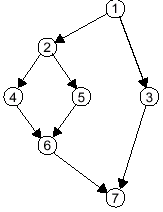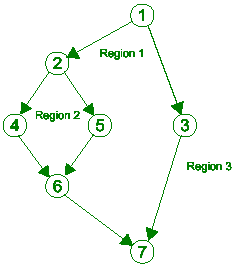|
(a)Identify any four features in fourth
generation language tools.[4 marks ]
Do not award half
marks. Alternative correct answers should be given credit, unless
otherwise indicated in the marking scheme.
• Database Query
• Report Generation
• Data manipulation
• Screen interaction
• Code generation
• Graphics/spreadsheets
Award one mark per feature; maximum four marks.
(b)The preliminary meeting or interview
is a technique designed to counter the
communication problems faced in requirements analysis.Describe briefly
the sets of questions asked in this meeting.[3 marks ]
• First set: questions leading to a basic understanding of the
problem. (1 mark)
• Second set: Enable the analyst to gain a better picture of
the problem. (1 mark)
• Third set: focuses on the effectiveness of the meeting itself.
(1 mark)
(c)Explain what is meant by the psychological
and engineering characteristics of
Psychological
characteristics: describes the relationship between a human person
and the programming language.(1 mark)
Engineering characteristics: describes the relationship between the
life-cycle and the programming language.(1 mark)
(d)Write down the seven steps involved
in transaction analysis .[7marks]
Seven steps are:(1 mark for each step each)
• Step 1:Review the fundamental system model.
• Step 2:Review and refine DFD for the software
• Step 3:Determine whether the DFD has transform or transaction
flow
characteristics.
• Step 4:Identify the transaction centre and the flow characteristics
along each of the action paths.
• Step 5:Map the DFD in a program structure amenable to transaction
processing.
• Step 6:Factor and refine the transaction structure of each
action path.
• Step 7:Refine the “First-Cut ”program structure using
design heuristic for
improved software quality.
(e)The following are statements commonly
made about software engineering;for each statement,comment and explain
in some detail how such a statement may be true:
(i)Fourth generation languages frequently encourage end-user development.[2
(ii)Second generation
languages have been superseded (or surpassed in usability)
by third generation languages.[2 marks ]
(iii)Assembly languages
are difficult to set.[2 marks ]
(iv)Analysts need communication
skills.[2 marks ]
Some of the possible answersare as follows:
Fourth generation techniques allows for creation of systems and programs
without the requisite of advanced programming skills …(substantiate
with examples and evidence)
Earlier generation languages do not make full use of features found
in more modern processors …(evidence)
Assembly language requires the understanding of usually non-natural
mnemonics or other cryptic symbols …
Communication skills are required as proper fact-finding depends greatly
on completeness and accuracy of information gathered from users during
the requirements determination phase …
0 marks for a simple iteration without understanding.
1 mark for a reasonable attempt to explain the statement, but the
answer provided is not conclusive. 2 marks for a good answer.
(f)The following is a diagram demonstrating
program flow for a simple program.

Copy down this diagram,and calculate
the value of V (G) using the regions method, clearly indicating where
your regions are.Write down the basis set of test paths.[4 marks ]
Candidates
are required to show their working by indicating where the regions
are. Award one mark for clearly showing the regions.

A total of three
distinct paths must be shown (1 mark each).
• Path 1-2-4-6-7
• Path 1-2-5-6-7
• Path 1-3-7
(g)Distinguish what is meant by alpha
testing and beta testing .[2marks ]
• Is typically conducted at the developer ’s site by a customer.
• The developer would supervise the testing, hence “controlled
environment ”.
1 mark for either point
Beta Testing:
• Tyically conducted at one or more customer sites by the end
user of the software.
• Developer not present, hence “live environment ”.
1 mark for either point
|

